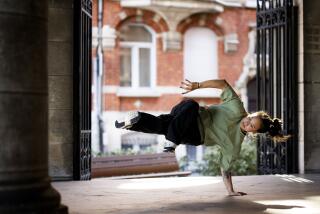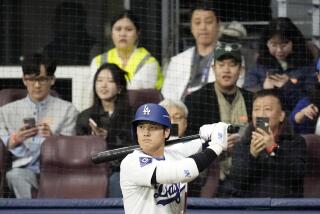On a Kick : Taekwondo Expert Hopes to Win Gold in Martial Art That Stresses Footwork
Even in his shorts and pullover, Jimmy Young Kim clearly is not just another Southern California college student. He sits with an easy, erect grace suggestive of a dancer, introduces himself with courteous formality and speaks of pleasing his family and friends.
Trained by his father since the age of 2 in the ancient Korean martial art of taekwondo, the 21-year-old Cerritos resident is considered a prime contender for a gold medal in the taekwondo demonstration matches at the summer Olympics in South Korea. His Olympic coach describes him as the most beautiful athlete he has ever seen, a lithe heavyweight who moves like a lightweight.
6-Hour Practice
At 6 foot, 3 inches, Kim could--if he wanted to--reach the rim of a basketball hoop with his kicks, executed with unusual swiftness. He says he has collected “between 45 and 50” medals since he started competing in 1974, including three national gold medals and three gold medals in international competition.
For months he has been practicing six hours a day at the Olympic training center in Colorado Springs, Colo., running, sparring and working out in preparation for taekwondo’s Olympic debut in Seoul this September. The martial art was accepted in this year’s games for the first time as a co-ed event on the demonstration level, and taekwondo enthusiasts hope it will become an official Olympic sport in 1992.
“I think it will make a great impression,” said Kim’s father, Chan-Yong Kim, who runs the Oriental Moo-Do Taekwondo School in Artesia. “People are looking for something new and exciting.”
Although new to the Olympic arena, taekwondo has been practiced in Korea for more than 2,000 years. It was introduced to the United States in the 1950s and has so grown in popularity that more than one million Americans now participate in the martial art, which emphasizes kicking rather than the hand work characteristic of karate. Often mistaken for karate, taekwondo is taught by a majority of martial arts instructors in this country, said the elder Kim, an eighth-degree black belt. The ninth-degree black belt is the highest level awarded in taekwondo.
Zen Buddhist Elements
Incorporating elements of Zen Buddhism, taekwondo translates into English as “the way of fist and foot fighting.” Competitors, who wear head and chest protectors, score by striking their opponent’s head or chest with sufficient force to make him or her stagger.
When he first instructed his son in taekwondo, “I wasn’t really thinking about Jimmy being in serious national or international competition,” said Kim, who will also be in Seoul as a taekwondo referee. Indeed, there weren’t that many competitions then, recalls Kim, a Korean native who lived in Australia and Malaysia before moving his family to Southern California and opening the Artesia school in 1971. The Kims have lived in Cerritos since Jimmy was in the third grade.
For Master Kim, as his students call him, taekwondo is a way of life, one that teaches respect, discipline and etiquette as well as physical strength and deadly techniques of self-defense. He learned it at the age of 6, when he was a “weakling” child during the Japanese occupation, and went on to become a professional after graduating from a Korean martial arts college. His two daughters, Susan and Jenny, are both first-degree black belts. Susan won the state championship in her class this year.
Jimmy, a 210-pound third-degree black belt, says he drives himself to please his family and friends. “I enjoy making people happy,” he said softly. “If I did this for myself, I probably wouldn’t work as hard as for my family and friends.”
“He makes his parents happy all the time,” Sang Lee, Kim’s Olympic coach, said approvingly.
Roland Ferrer, another Cerritos taekwondo champion and a longtime friend of young Kim, calls him a gentleman competitor. “He’s very smart, very strong and very fast,” said Ferrer, a first-degree black belt trained by Kim’s father.
This year’s national middleweight champion and a three-time state champion, Ferrer, 26, also trained for the Olympic team but was not selected when the final cuts were made early this month. He is now looking ahead to October, when he plans to compete in the world collegiate games.
Unlike Jimmy Kim, who wants to go into sports medicine, Ferrer would like to continue professionally in taekwondo --albeit in a decidedly untraditional fashion. He is interested in combining elements of dance and taekwondo, staging and choreographing them with music.
Young Kim, who has taken off the past year and a half from his studies at Cal State Long Beach to train and compete full time, says he wants to win a gold medal in Seoul and return to the classroom. He adds that he isn’t planning to compete in the 1992 Olympics.
But his father, smiling fondly, glanced at him and said, “I think he will.”
More to Read
Go beyond the scoreboard
Get the latest on L.A.'s teams in the daily Sports Report newsletter.
You may occasionally receive promotional content from the Los Angeles Times.







